BEYOND THE CLASSROOM with Erin Chamberlain
LBCC'S ECLIPSE CHASERS
Students Travel to Study Solar Eclipse
COASTAL SATURDAY
Band Spotlight

BEYOND THE CLASSROOM with Erin Chamberlain
LBCC'S ECLIPSE CHASERS
Students Travel to Study Solar Eclipse
COASTAL SATURDAY
Band Spotlight
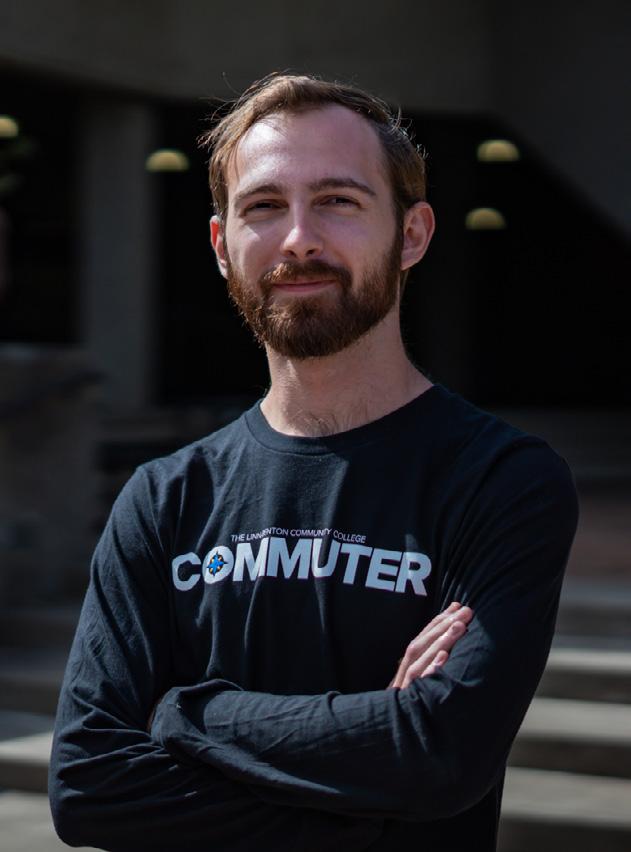
We're already a little over halfway through spring term somehow. I feel like the term just started, spring term really flies by. Hopefully, you’re able to breathe and relax for a minute after midterms. If you are having a rough time managing everything at this point in the term, the Commuter has you covered!
May is Mental Health Awareness
Month, we talk a bit about resources available to students in our Roadrunner Wellness article for this edition. We’ve had a Wellness Wednesday column we feature on the Commuter site written by Jana Svoboda, it’s made occasional appearances in the print magazine. Starting in March this year one of our reporters, Jessica Reynolds and Jana Svoboda teamed up to work on a print column spinoff of our digital Wellness Wednesday. We’ve been featuring an Ask a Therapist column as well to help answer all your wellnessrelated questions.
Mental health is a topic that people have varying opinions on but I believe its place in academia should not be overlooked. College is stressful, you are constantly needing to juggle assignments and meet deadlines for multiple classes. A lot of college students also have jobs in addition to classes that carry their own responsibilities. On top of that, you gotta figure out how to pay for classes while also supporting yourself. That’s a lot of stress and we’re only human. Wherever you stand on the topic of mental health, knowing how to manage stress is vital to your success in college. You may want to charge through it all and pretend you’re invincible but if you ignore
your mental well-being, it will weigh you down. Make sure you’re taking care of yourself, LBCC has a ton of resources to help you manage whatever you’re facing and keep your head happy.
The feature article of this edition is about the eclipse that happened last month. Alexis McLean worked with Greg Mulder and his group of LBCC students who took a trip down to Texas to view the eclipse. It was a beautiful astronomical event that was luckily captured on camera. The photos are stunning and made for an awesome story for this edition. I only wish I could have seen the event myself.
Another exciting development I'm proud to announce is that the Commuter attended the annual Oregon Newspaper Publishers Association Collegiate Awards and won 19 awards as well as 2nd place for General Excellence. I couldn’t be more proud of the work our outstanding team of dedicated writers, designers, photographers, editors, marketing specialists, and reporters create.
Thank you all for reading and your continued support. I hope you enjoy the stories we packed into this edition.
Ryan Janowitz Editor-in-Chiefthe Commuter is the student-run magazine for LBCC, financed by student fees and advertising. Opinions expressed in The Commuter do not necessarily reflect those of the LBCC administration, faculty and students of LBCC. Editorials, columns, letters, and cartoons reflect the opinions of the authors. LBCC is an equal opportunity educator and employer.
The Commuter encourages readers to use its “Opinion” section to express their views on campus, community, regional and national issues. The Commuter attempts to print all submissions received, but reserves the right to edit for grammar, length, libel, privacy concerns and taste. Opinions expressed by letter submitters do not represent the views of the Commuter staff or the College.
wanna get together? We’re really nice and fairly cool and we’d love to hear what you have to say. Not big on journalism but love to journal? Perfect. Are you a STEM major with major opinions? Let’s hear ’em. Like writing about ’80s film? Local animals? Snack hacks? Maybe you have a hefty folder of flash fiction on your laptop, just dying to be published and printed. Drop us a line. We’d love to meet you, read you, and support you. Think your ideas might be too weird or too niche for submission? Even better. The Commuter is an award-winning publication because of our wide range of contributions and our unique contributors. So reach out. We’ll be staring at our email inbox in the meantime, not an ounce of chill to be had.
EDITOR-IN-CHIEF
RYAN JANOWITZ
DESIGN EDITOR
KAILYN MCQUISTEN
PHOTO EDITOR
SARAH ROSE LARSON
FEATURE EDITOR
AVERY JADE
SPORTS EDITOR
RYLAND BICKLEY
NEWS EDITORS
EAGLE HUNT
EMILY JIMERSON
ALEXIS MCLEAN
JESSICA REYNOLDS
EDITORIAL ASSISTANT
VIC PFLEGER
MARKETING DIRECTOR
CHRIS PATTERSON
REVIEWS
STEVEN PRYOR
MASON WILLS
ADVISOR
ROB PRIEWE
CONTRIBUTORS
BRENDA AUTRY
ETHAN BIRMINGHAM
JEREMY HANEY
ALEXIS MCLEAN
JANA SVOBODA





















Forget rote memorization, long lectures, and hours of textbook highlighting. Linn-Benton biology instructor Erin Chamberlain presents an ever-evolving curriculum. Chamberlain is a passionate educator who believes in the power of fostering a love for science, a greater understanding of the world we live in, and the tools to continue discovery long after the classroom.
Chamberlain has been with Linn-Benton Community College for eight years now. At LBCC, she teaches the undergraduate biology courses Bio 101 and 102.
After Chamberlain had been at LB for a couple of years, she, along with another LBCC instructor, took curriculum development into their own hands, crafting a dynamic learning experience that goes far beyond the textbook. Driven by a commitment to effective teaching styles and placing value on student feedback, Chamberlain is transforming the way students engage with the biological world. Her innovative approach sets students at ease and creates a curiosity that leads to effective learning.
You are teaching here in Chinook Hall instead of the Albany campus this term. How has that experience been?
I really like it here. I mean, I don't see a lot of people, but it’s great, and the commute is way better. I live less than a mile from here. It's really nice. I also work at OSU, so I'm kind of just all here in Corvallis now.
What do you do at OSU?
Well, I teach one in-person class that's like working with undergrad TAs. They're called learning assistants. They are in science and math classrooms, trying to help active learning students. They have to take this class to gain some better strategies and be more successful. I also teach an online class for future math science teachers. In addition to supervising a couple of student teachers in middle school and high schools within Corvallis, I get to watch them teach. It's really busy.
Have you always lived in Oregon?
I was born in Nevada, but I grew up in Oregon. My parents moved here when I was a baby. So I grew up in the Willamette Valley, in Newberg, not too far from here. I've been here a lot except for maybe four years in undergrad when I was in Idaho. I was also in Idaho, a different place, up in Moscow for two years for grad school.
One of the ways Chamberlin encourages engagement in her classroom is through a program called Wooclap. It works by allowing instructors to create polls, quizzes, and other activities that students can answer in real time using their smartphones or laptops. This can help to boost engagement, gauge understanding, and make learning more fun. At the beginning of the term Chamberlain and students enter questions they have about the class.
There was a question for you on Wooclap, "Are you married to the earth science teacher?
Yeah, I am married to Deron Carter. How did you guys meet?
I worked and lived in Central Oregon, and we both worked for OMSI, the Oregon Museum. They do these outdoor science education camps for outdoor schools during the school year and then science camps through the museum. We met out at one of those a long time ago. We met there, and then we both went to grad school. I went to Moscow, and he went to Ellensburg in central Washington. And so we were like, “Ok…,” but then we ended up each driving one way once a month, so we’d see each other twice a month. That was for a couple of years. What is your educational background?
I have my undergrad in biology – it's always been my favorite. That was a small college in Idaho. Then I have my master's in environmental science, that is what I did after OMSI.
I just realized I loved science, but I enjoyed working with students more. When we moved back to Oregon together, we lived in Salem while Deron taught at Western Oregon. I got a job with AmeriCorps at an environmental middle school there, and it was really fun.
I worked in the classroom, and the students went on tons of field trips and adventures. Then we moved here, and I went back to school again. What are some of the differences between teaching college and teaching middle school?
There's a lot of similarities, I would say. I think that all students want to be engaged and interested in doing something fun and interesting. I don't think that stops in middle school.
Of course, the differences are a lot fewer behavior issues. There are always one or two that pop up in a year in college, but it’s very rare. Generally, in college, the worst thing is people don’t come to class, which is sad. But in middle school, there are lots of things going on in life, and sometimes, they don’t know how to control
themselves in the classroom.
I haven't taught middle school for a while, probably 10 years since I taught. Maybe it's been a little longer, and I think it's gotten harder. I go into the classrooms with the teachers I'm helping. It's a lot.
How has the experience of teaching middle school influenced the way you teach college now?
I learned a lot when I taught middle school and how to do it better. Every time you do something, it's practice. You are always trying something new. That's the best part of teaching, reflecting, and continually making things better. I think I took a lot of practice from when I taught middle school to what I do now. But I also think I've grown up a lot since I taught middle school, like having my kids. I think I've learned a lot that I didn't know when I was in my 20’s.
When I was getting my master's in science education here, I had at least one really cool mentor teacher. He taught at OSU, but his background was teaching for about 25 years in the public school system.
What were some of the benefits you got from having a mentor?
I feel like I learned a lot from the program, research and evidence-based practices of how to teach, but also just the way he taught. From him, I learned to have more empathy and understanding. I still think about him. I haven't talked to him or even know where he is anymore, but he was really helpful that year and even a little bit the year after, too. I would email him sometimes.
I think I was influenced by having a teacher who was just so thoughtful and kind. I could tell how much he cared about students and always wanted to do what was best for them, not just what was best for him. But he was also really good about balancing. He taught me how to help students learn while also managing your own workload. He just had a lot of really great ways to think about how to teach. I think about some of the specific things he did, he wouldn’t just teach, he would also apply it. Not all teaching programs are like that.
What is your teaching philosophy?
There's been so much research in education best practices that generally aren't applied. I'm surprised even in K-12, but not in college. I'm just trying to take what I learned, what actually works and helps the greatest amount of students. Nothing will help all students, but the things that
I think and know from the research is how to get students to actively think and talk about the material using relevant and interesting examples that apply to the world around them. Ways that they can actually really see the connections.
Also, I think I should be really transparent about the goals of what I want my students to learn and then plan everything I do around those goals, not getting too far off-topic.
Once I have my goals in place, I really try to think of as many ways as I can to avoid lecturing. That’s why I do some pre-class assignments. That way, students come to class prepared and ready to talk to each other and think about the topic in new situations.
During class, I think it's important to sometimes fix misconceptions after students have tried something. I like to walk through that process to make sure that everyone gets it because even though students are talking, it doesn't mean everyone gets it. They might need to hear it a different way.
And just planning lots of discussion, activities, and ways for students to apply what they’ve learned and then hopefully at least enjoy some of it, too.
I'm always trying to think of new examples or ideas that feel fun, are enjoyable, and are not too boring. I mean, not everyone is going to learn or listen. We have too many distractions nowadays with phones and computers. I see it still, no matter how hard you try. But I think the more you try to engage students and actually ask them questions, the better.
I don't want them just to memorize a whole bunch of facts; I want them to understand and be able to apply them. That’s what I really think about for lectures, labs, and assignments. I try not to make it busy work. I can’t guarantee that every student feels that way, but my goal is not to create busy work, instead to actually work towards the goal of learning these things.
Out of the content that you teach, what is something that you think students find the most surprising or interesting?
It’s always evolution and natural selection. I teach that in 102 for two weeks or so. I think many students come in with misconceptions and thoughts about it and maybe don’t fully understand how populations can change over time.
By the end, a lot of students feel pretty confident and really are surprised at all the different examples of natural selection that you can really witness and explain.




Students are also surprised at how well they're able to apply it when I ask them to do it in new situations. That's always one of my favorite ones. I think students generally really enjoy it because they've never thought about natural selection in that way before. They've often thought about it but don't hear some of the other concepts or how it actually applies as often in our cultural society.
What about applications, something that you feel like students can apply that they might not have necessarily before taking one of your classes?
I think it’s probably in 101 to understand more about ecology and the connections between nutrients and energy, all the different food webs, and populations. I think that feels really applicable for a lot of students because they go out and they see that right away.
You just walk out the door, and you can notice those things. I found that more students tend to come in and say, "Oh, I saw this," or "I have a question about this." Just today, I had a student who had pictures on her phone from her hike this weekend. She asked me to look at them and was asking questions. I think those concepts are so easy to apply and be curious about because it's just like right in front of you. It's a lot harder with the cells.
Why did you first want to go into science?
My dad was a professor at a college. He taught organic chemistry. My mom wasn’t in science, but she’s a teacher. She got her teaching master’s when I was in high school. She’d gotten her teaching degree before kids, and then she took a long break. I don’t even know how she did that when we were kids and went back to school. She was amazing.
So I had two teachers as parents. I don't know… I really enjoyed my high school science, especially biology. I kind of thought that's what I would like in college. And then when I took it in college, I just loved all the biology. I loved it all. I think the professor I connected most with was the ecologist, he was really awesome. He was the one who was my mentor in college.
One summer I spent there, we did this big butterfly project. We got to build traps, monitor and collect butterflies, and track them. It was really fun.
Chamberlain’s labs can be described as interactive and fun. It’s a place where one day, beans are elephants, and the survival rates of bubbles blown from a bubble wand are tracked. Where squids are carefully dissected and the sculls of various animals are investigated to determine what trophic level they may be based on what kind of teeth and eye sockets they have.
You have mentioned before that when designing the curriculum, you tested activities on your kids?
For 101, that particular lab manual, I and another part-time instructor applied for a grant to rewrite it. It was needed, and we thought it would be fun to update it.
We looked at the old one, and we used some stuff, but we also wanted to come up with some more activities to get students able to move towards learning some more complex topics. We practiced a lot of things together. We'd take things home and do them with our kids, like the marshmallow one we do in 101 where we were modeling antibiotic resistance.
We have marshmallows, which are modeled as bacteria that are not resistant to antibiotics. Then, one has a mutation, and it becomes a bean, which is now modeled as resistant. We introduce antibiotics, which are the toothpicks. Students try to stab as many marshmallows and beans as possible within a certain amount of time, and then we replicate whatever's left.
Ideally, the antibiotic-resistant population grows over time because it’s hard to pick up a bean with a toothpick, and then the other one decreases. But it was funny when I did it with my son. He realized pretty quickly, and sometimes I’ve had students too, that the toothpick is sticky from the marshmallow, and he can actually pick up the bean a little bit.
We have tried a lot of stuff at home, especially during COVID. I was like, "How do I do this when I am teaching online?" So the kids helped me do some of the labs and we'd videotape it together for people to watch.
Having two science teachers as parents, how much is science a part of your household?
Oh, I don't know. I mean, we talk about it. We love going on hikes and looking at things. I wouldn't say either of my kids are overly excited about science, but they don't hate it. So that's good. They ask lots of questions, and they're very curious. I feel like they're still so young. It'll be interesting to see.
Tell me about bighorn sheep.
Oh, yeah. I do things in both of my classes about bighorn sheep. In 101, I talk about my friend Regan. She studied bighorn sheep when we went to grad school together. I got to go help her with that one summer. She had such a great scientific experiment. It was more observational, with a variety of ways of trying to understand why the population was decreasing.
I have used that as a great way to demonstrate using the scientific process of thinking like a scientist. How do you go from wondering what happened to this population to trying to come to some sort of conclusion and using what Regan did along the way. It's also just such a fun way to think about population ecology because there are so many possibilities, then having students try to predict what happened. In the end, it's a little bit surprising that it was the mountain lions or the cougars that were eating them, which they normally don't eat bighorn sheep.
Then it is tied to this other population increase of deer nearby. I think it's kind of a fun, surprising thing that no one predicted. Sometimes people predict predators, but not why.
What are some careers in science a person might not know about?
Job opportunities? I think teaching is a really fun way. That's what I found is my very favorite way to be a part of science. Some people do straight research.
I was just meeting with my group of friends from grad school, and we've all done different things. We all went to grad school with similarish ideas, now, my one friend works in Corvallis at Fish and Game. She's at the top of her field by now, understanding climate and how it's affecting fish.
I have another friend, Regan, who does management. She works as the head of the McCall Fish and Game Wildlife. She is maybe one of the only women in Idaho who is a field manager.
Some people end up learning to work more with people or conservation. My friend Nicole is a conservationist. She works with people. She is such a good people-person. She works with farmers and ranchers to see if they're interested in using some of their land alongside the Tualatin River doing some rehabilitation or restoration of some parts of the land, or figuring out how to move cows in different ways on their land and also still have an ecosystem that other organisms could use. She likes to go out and just talk to people.
I think there are just so many fun and interesting ways to be a scientist. What encouragement would you give students who either struggled with science in high school, didn't have much of a science program, or have been out of school for a long time and have to take science classes?
That's always my hope with this class, that people are less afraid of science.
That's always one of my objectives. A lot of people come into college not liking it or being afraid of it. That's not always true. But one of my goals is hopefully you can leave and feel at least neutral. Or when you see something science in the news, you're like, "Oh, I can do this. I can read this and understand it."
I just encourage them to be open and curious because science isn't just like a series of facts, but it's like a way of thinking, it's a way of seeing the world. You don't have to be a scientist to think like a scientist and see the world like a scientist. I think you can go into a science class being open and willing to look at the big picture and think about how it's more relevant to you.
You might enjoy it more than you think, versus going in there just assuming, “I just have to memorize all this stuff, and there's just lots of vocabulary,” which can feel overwhelming.
We know the research: If you’re just trying to learn a whole bunch of separate things, your brain struggles to make those connections, which makes learning hard. But if you’re always trying to think about how things are connected, asking questions, and thinking about how what you did this week connects to last week, your brain is actually able to build more connections, and you’ll be able to learn more easily.
What kind of understanding of science do they have to come in with when they are taking Bio 101?
You can come in with nothing. I’ve had such a variety of learners that I don’t think you have to come into class with any prerequisite knowledge. It’s a willingness to want to learn, work hard, and ask questions.
Any final thoughts?
I just absolutely love teaching biology, and I hope that comes through. I really like it when students give feedback, and I can learn. I just hope students will always know I'm willing to listen and recognize when sometimes things aren't working.
My favorite part of teaching is not doing the same thing over and over and over again but continually evolving and improving with new groups of students and with new and exciting things happening in the world. It’s constantly trying something different, and sometimes it fails, but that's okay because it is so important to just try something new.





LBCC’s eclipse chasers have come back home.
On Tuesday, April 9, the team of about 16 LBCC students arrived back at Eugene’s airport after a long-anticipated weekend of preparation, experimentation, and data collection in Leakey, Texas during this year’s total eclipse. For 14 weeks the students learned the history of the experiment, its significance for accessibility, and finally how to perform it.
The goal of the project was to recreate the 1919 Eddington experiment, which proved Einstein’s theory of relativity, but with materials that were more accessible than those Eddington used, such as a massive telescope and silvered plates. The experiment takes advantage of eclipses' obscuring of the sun’s overpowering light to identify the effects of gravitational lensing on the stars behind the sun in comparison to those stars at night when the sun isn’t there.
One of the project’s beginnings was back in 2022 when Heather Hill and two students received a $15,000 grant from OSU to write some code to manipulate a telescope’s motors without the use of an expensive external program. They presented their work at the Oregon Space Grant Consortium Student Presentation Event.
Then, a $20,000 grant from NASA became available for the cost of this most recent trip to Leakey, Texas in the interest of modernizing the Eddington experiment for any individual or institution who wished to recreate it themselves. The code written by Hill and the students unfortunately ran too slowly to facilitate the experiment’s automation.
Hill explained the manual alternative:
“Originally they were going to do it manually, which means that we have a hand paddle which you can push an arrow left, right, up, and down and you would make it move by manually pushing a button. And the thing is, that’s imprecise because we wanted to get 10 degrees to the right side of the sun and the left side of the sun, so it’s not very reproducible or accurate. So it’s actually better to automate it because then we just tell the computer program to tell the telescope ‘Go to this point, go to this point, go to this point.’”
Kenneth Carrell, a professor from Angelo State University in Texas and a collaborator




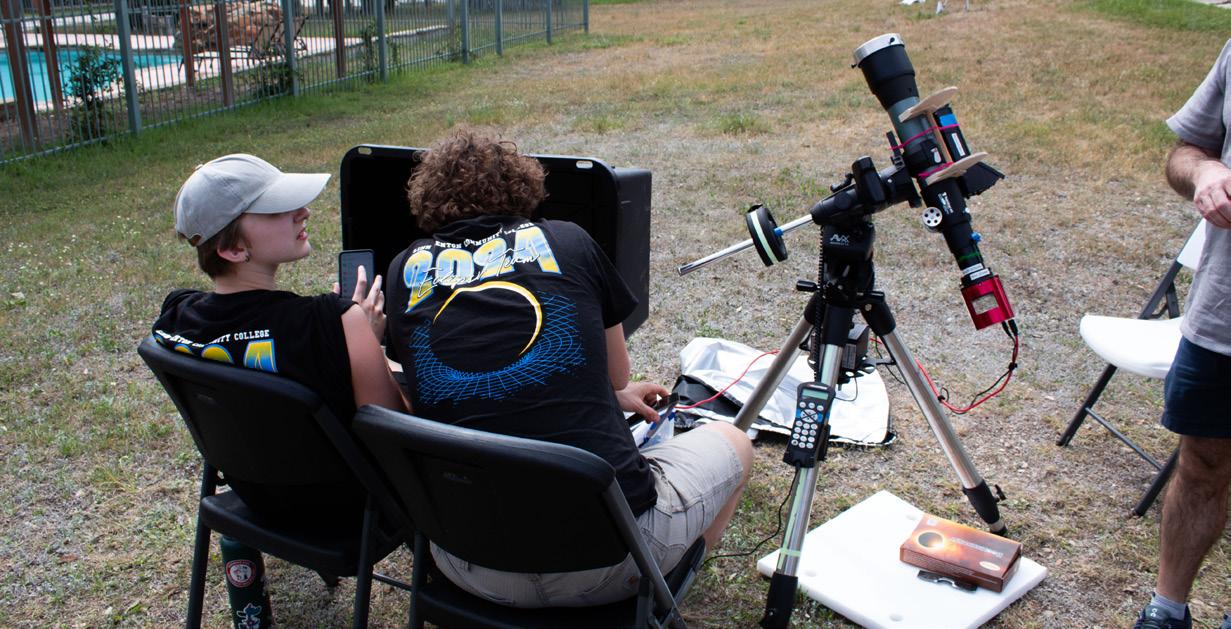


since 2023, suggested they change plans. He had written some Python code that two students had 24 hours to update in order to fit LBCC’s plan. Hill had actually avoided telling the students about his option herself to avoid stressing out the students.
“We didn’t know if it was going to work, I mean … it was going to work, I don’t know! You know, when you change things 24 hours ahead of time that’s not a good idea,” Hill said.
LBCC physics instructor Greg Mulder seconded these feelings:
“We had, for the past many weeks, to have a person manually follow the sun. We decided to create hardware and software that would allow the telescope to automatically follow the sun and you know the last 24 hours toward the eclipse the group decided to automate and that’s a pretty risky move to change what you’re going to do at the last minute, but in this case it turned out it worked out.”
Unfortunately, while the last-minute change to full automation went smoothly, the weather in Leakey, Texas was not ideal for the experiment. Weather patterns guided where they decided to have the experiment and unfortunately reality went exactly the opposite as expected with clear skies in the Northeast and clouds in the Southwest.
Before the eclipse there was a lot of anxiety about what the weather would be like in the critical moment. Hill explained, “Leading the few days before the eclipse the night skies were beautifully clear, you could see for days, it was dark because we were in the middle of nowhere,but the day the eclipse happened, it was cloudy. It was pretty bad.”
“It wasn’t a complete fail but it was definitely disappointing. We had two teams collecting data, one team was collecting data from light polarization data and their data didn’t rely on there being clear skies. So, they got good data. The other team was using the telescope and was trying to look for stars from the gravitational lensing. I honestly haven’t looked at it because I’m too afraid.”
Thankfully, Mulder said teams were collecting gravitational lensing data in Ohio and Mexico that can act as a backup for data that was unable to be collected in Texas due to bad weather.
Despite the less-than-ideal conditions, the students were not only able to practice working in the field but also had fun swimming in the river, eating barbeque, and watching “The Lord of the Rings.”
Looking to the future, plans are in the works for trips to northern Spain in 2026 and Egypt in 2027 to repeat the experiment and hopefully finish some code without the use of outside software.
▲ Photo by Heather Hill
Game Night is on Monday, May 13th from 4-7PM in the Commons Cafeteria.
The Waverly Park Clean Up is on Saturday, May 25th from 11am to 1pm.
The Trivia Extravaganza is on Wednesday, May 29th from 12-2:30PM in Roast Runners.
Civil Discourse Gatherings
Tuesdays 12 - 1 PM
Equity Center Forum 220
Human Rights Club
Wednesdays 1 - 2PM
Equity Center Forum 220

Poetry Club Tuesdays 3 - 4PM Equity Center Forum 220
Gardening Club
Mondays 1 - 3PM Garden Greenhouse near Luckiamute Center
Find out about more clubs at: https://www.linnbenton.edu/student-life/clubs-andprograms/clubs.php, or contact slcclubsengage@linnbenton.edu
Are you following the SLC on Social Media?
Looking to express your love for writing and gain a supportive community of like-minded students? LBCC’s Creative Writing Club may be the perfect place for you.
The Creative Writing Club’s mission statement is “to create a friendly community for writers of all levels to grow through practicing their craft with writing prompts, collaborating on projects, and sharing work.”
As a small group of LBCC students who are passionate about writing, the Creative Writing Club meets together weekly to support each other and give and receive feedback on their works of fiction. The club meets every Tuesday at 3 p.m. and is always open to new members who want to come and see what the group is all about.
According to Student Representative Coen Olsen, if you’re interested in joining the club you don’t need a lot of experience, you just need to have a love for writing.
“The word amateur is derived from the Latin verb ‘amare,’ which means to love, and I feel that captures the creative writing students. We are all lovers of writing, of creating worlds.” Olsen is majoring in creative writing at LB.
When asked how students can get involved with the CWC, Cooper Madison-Dawson said, “Just show up. Honestly it’s just about showing up and being consistent.” Madison-Dawson is also studying creative writing at LBCC. Club member Andy Olsen, who is majoring in dietetics, had a different take. “It’s also worth noting that it’s OK to be a more casual member and only show up sometimes. There’s a lot of acceptance to different schedules and things like that.”
There are around 30 members total who participate in the club via Discord. The in-person meetings typically consist of a half dozen members who meet in North Santiam Hall, room 106 on the Albany LBCC campus. At these gatherings, members share writing projects they’ve been working on and receive feedback from others. According to Madison-Dawson, they discuss the content and structure of their stories, suggest improvements, and make adjustments. A story or a scene will be read by each member followed by praise and critique. Madison-Dawson, who will become the club’s next student representative in the spring, said that some members look for help with grammar and spelling, some for feedback on the structure and flow of sentences or dialogue, and some for plot and character development.
All of the student members write creative fiction, but according to the club’s advisor, Dio Morales, every kind of prose is welcome. Morales is the only creative non-fiction writer within the club and she is always excited to meet other non-fiction writers. Some of the members are in the process of writing novels or manga, while students such as Andy Olsen are working on web comics and other works of fiction. Genres within the club range from fantasy, adventure, mystery, contemporary, romance, and more.
Most of the members learned about the Creative Writing Club, also known as the CWC, through Welcome Day at LBCC or through one of their writing instructors. Coen Olsen said he first got involved through Rob Camp’s Roadrunner Connections course.
When asked what his roles are as the student representative, Coen Olsen said, “My roles include making sure we have a representative at Council of Clubs meetings, booths reserved and manned for events like Welcome Day, and information slides to share with interested members. In the past, I have also helped find new activities for club members, like writing prompts for flash fiction and Ransom Notes for game nights. Right now, I am very hands-off as our current members are very self-driven.”
The club has been restarted many times over the years and was most recently revived by Morales in 2020. The club met on Zoom during covid and the Zoom call is still an option for members who prefer to participate remotely. Members are also welcome to ask for feedback on their creative prose through the Discord server.
In the past, the CWC was merged with the Poetry Club, since they meet at the same time on Tuesdays. MadisonDawson brought up the idea of pushing their club meeting time back an hour, so they would meet at 4 p.m. instead of 3. This way, members of the Poetry Club could swing by after their own gathering and share both their poetry and works of prose with the CWC. This would also expand the CWC’s numbers, since they currently only have around 6-10 active members who attend the meetings.
As the club advisor, Morales opens up the room and gets the meetings started. She also helps guide the club, answers questions and provides writing resources, and participates in group discussions.
“The club evolves based on what the interests are of the members. This year the interest has been really strongly in the direction of folks sharing work online, bringing work in and discussing it, and supporting each other as writers,” said Morales.
In the past, a previous rendition of the Creative Writing Club did some work for the Commuter, a form of group writing called exquisite corpse, where one member starts a line of poetry or prose, another member writes the next line, and so on until the work is finished. According to Madison-Dawson, the current club would love to get involved with the Commuter again and submit some of their work if opportunities arise. The club cultivates a supportive and inclusive environment for writers of all skill levels, Madison-Dawson said.
“We hear each other out. We have very personalized discussions where we give the floor to the writer, the writer will work on something and read what they work on, and then we’ll all bring a bit of our own thoughts and ideas to the table.”
Andy Olsen said, “There’s a lot of different flavors that critique can come in, it can be like, ‘I think there’s some big structural issues with this,’ it can be, ‘I don’t know what I want the plot to be,’ or it can be, ‘Hey can someone do a typos read-through, please?’”
Madison-Dawson said, “Yeah, it’s whatever you’re looking for too as the writer, we can cultivate that experience. Because not every writer wants to have their work critiqued on spelling and errors.”
When asked about how their experience has been with the CWC, the members said they’ve enjoyed being a part of such a supportive writing community. Wade Johnson, an LB student studying mechanical engineering, said, “This is my third or fourth meeting so far, but it’s been very helpful with my writing. It’s nice to have people that I can talk to about my story.”
CWC member Macie Cooper, who is studying computer science at LBCC, said, “I would say it really pushes you as a writer in not necessarily a new direction, but in a direction. You come to the club with your work so then you’re motivated to write more, to produce more work. Also reading other people’s stories and seeing things that you like or you don’t like, it really helps form your own story. The critique you receive and the critique you give are both really helpful to your writing process.”
at

Monday-Friday 8AM to 3PM
I’m no mental health professional. I’m just another student here taking it one step at a time down the path toward my next thing. For me, hopefully that’s a bachelor's degree at Oregon State University, and then business ownership. Only time will tell. Why am I writing a wellness column, you ask? Well, as a fellow human, and one who has absolutely struggled with issues of mental health and overall well-being, I can relate! I’m a little older than some students at 36 years old, so I feel like I have a little experience under my belt, having gone through the struggles of my young adult years, and now facing the struggles of my thirties. I’ve got kids, body issues, anxiety, and honestly sometimes a temper, just to name a few of my struggles. If I can help you to feel supported, a little less alone, or even if I can just connect you to someone who can help you more than I can, I’ll call it a win.
By the way, I’m Jessica.
May is Mental Health Awareness Month, and with Spring arriving, better weather is almost here and I’m thrilled!
As I write this, it is currently raining, but I can definitely see the light at the end of the tunnel – better weather with plenty of sunshine is just around the corner. This doesn’t relieve the academic pressure you might be feeling, however. Sometimes I feel like I only ever see the inside of the Learning Center or Starbucks as I have loads of homework to do. It’s so important that you and I remember that it is critically important to connect with others for our well-being even amidst stress and fatigue. It can even be rejuvenating, giving you a boost of energy and maybe even take a touch of tension out of those shoulders. Make sure you take some time out this week to meet a friend to enjoy something you share – a walk, cup of coffee, gym workout, farmer’s market, or whatever you like. Talk about the things happening in your life, and make sure to listen as they share as well. Really connect! We spend so much time on Moodle and our phones that we forget how refreshing it can be to sit face-to-face with the ones we love.
When it comes to our struggles in life,
another way to connect with others and get and give help is to join a support group. Whether you’re facing grief, addiction, LGBTQIA2S+ issues, domestic violence, parenting, or a myriad of other things, there is likely a support group near you or online that can help. The beautiful thing about a support group is that you’re often all in it together. Some may be further along and others brand new, but you have unity in the struggle… and the success. It can be a great way to find a mentor. Mentorship is one of the most successful strategies to getting to the next level in life, no matter the topic. If you need help finding a support group, reach out. Jana Svoboda in the Advising Center (Takena Hall) would be more than happy to help you navigate the path to finding a group that works for you.
So, for this month, let’s get our work done, but let’s also prioritize connecting with others!! We’re all in this together! (High School Musical, anyone?)
LBCC Advising Center: 541-917-4780
Short-term counseling
Crisis Support (after hours or for immediate help call 541-917-4666; available 24/7)
Community health resources
Linn County Mental Health - (541) 967-3866
Outpatient Services
Crisis Support
Benton County Mental Health 541-766-6767
211.org or dial 211
Connection to local resources
One2Another - (541) 570-0284
C.H.A.N.C.E - (541) 791-3411
Addiction Recovery
Homeless Services
Suicide and Crisis Lifeline: 988

Questions welcome! Email svobodj@linnbenton.edu Questions may be edited for length and clarity, and details changed for privacy.
I’m looking into starting therapy. What should I be looking for? Does it matter what their credentials are (counselor, life coach, psychologist, psychiatrist)?
Dear Looking: Counselors, social workers, psychologists, psychiatric nurses and psychiatrists can all be licensed in Oregon to provide therapy. Licensing means they have had specific training and education and passed a state and professional test for practicing. They are also able to diagnose and treat behavioral health conditions (depression, anxiety, etc). Insurance usually covers most or all of their services.
Only doctors and master’s level nurses/physician assistants can prescribe medication.
Life coaches may have a certification that involves training or supervision but the amount and quality can vary and they are not required to be licensed and the profession is not regulated. Insurance will not pay for life coaching.
Like any profession, individual performance will vary and professionals will have different levels of experience and scopes of practice. Look for someone who has experience treating your symptoms or situation. Search engines such as Psychology Today can filter your options by insurance taken, age groups treated, diagnosis, or expertise in a specific area. For example, if you’re looking for a female therapist that specializes in ADHD and takes OHP, put those terms into the filter to generate a list of names. Then read their profile to get an idea of how they work and what they offer.
Someone close to me has shared that they are having suicidal thoughts. What should I do? This person trusts me, and I don’t want to betray that, but I’m really worried about them!
Dear Trusted: It’s good they were able to share this with someone, but it’s too much to hold alone. Assess for safety. If you think they are in immediate danger, get them to the Emergency Room or call 911. If they are safe for now, encourage them to reach out for help from their PCP (primary care provider) or a therapist. Share local resources such as the national suicide hotline (dial 988) or, if they’re a student here, the LBCC crisis line number (541-9174666). You can call those numbers too, to help you find out how to assist your friend. Sometimes I’ve had to call a supportive family member or partner or even the police to check on someone who was in danger but refusing to get help. I’d rather have them be mad at me than dead.
Often when people are feeling suicidal they are also feeling ashamed, helpless and hopeless. If you’re able, walking them into a crisis center (local mental health department, or the counseling office) can help. Listening, supporting and connecting them to help can make all the difference. But don’t forget to take care of yourself, too.


Tell me your major, grade, and what brought you to LBCC. I am in the Visual Communications program and currently about to finish up my first year. I was born in Corvallis, so LBCC just honestly seemed like the best option for me because I didn’t really want to move around too soon.
What sparked your interest in graphic design?
I’ve honestly been drawing my whole life, but I never really took it all that seriously. Most of my life you know, I’d just kind of doodle in the margins of my notebook and all of that. I started at LBCC and my classes, at the beginning, were really rough so I decided that I would maybe just try a class or two that would be a little more fun for me. I picked up a drawing class and I ended up really enjoying it, so I just started taking more and more art focused classes. Then somehow I just kind of ended up falling into the visual communications program and realized that was the right move for me.
In the future, are you hoping to work for a specific graphic design company or do freelance work?
I am looking into freelance work, but I do enjoy working for people, just because it helps with, you know, having a more specific direction. I have been working as a screen printer for the past couple of years while I’ve been in school. Through that I met a really good mentor of mine, his name is Brady Chambers. I was working for him for about a year, and he has kind of a self-built screen printing shop in his backyard and so he basically does everything himself— aside from my help—and I really do like that self-built sort of thing. But I’m really open to anything, and I would also be really interested in doing some larger scale work, maybe with posters. I really enjoy concert posters and that sort of design realm.
Tell me more about what kind of work you’ve done for screen printing shops.
Currently I work at Shirt Circuit. We mostly just print T-shirts for smaller companies that are more local. We do a lot of work for OSU, the fire department, and the police department. So honestly it is labor, but I really enjoy it just because I get to be around art all the time and I get to see the outcome of graphic design. It’s nice to be able to be learning about the business from both ends essentially.
If you could only use three fonts to design with, which ones would they be?
I really like Reross, Garamond, and New Order.
What gives you inspiration to create?
I draw a lot of my inspiration from music and I would say photography is a really big one for me. I love looking at old photos and going through old photography books and graphic design textbooks. I’ll go to used bookstores and look for any kind of books on art that I can find and look through them. I do a bit of reading, but honestly a lot of it is just looking through the pictures, seeing what catches my eye, and seeing how I can kind of turn that around into something a little more of my own.
Are there any role models you look up to and why?
Specifically in the LBCC program, I really feel like Lewis Franklin has been a great role model for me. He always is so helpful with his ideas and the way he’s able to kind of get through to me. A lot of the time I feel like I can get a bit lost in my projects and not see the forest for the trees, and Lewis is really good for helping me get back on track. Also, Anne Magratten has been really great for me as a professor, just the environment that she creates in her classes is very encouraging and it makes me excited to come to class.
What have you enjoyed most within the graphic design program at LBCC?
Honestly the people. I love all of the students surrounding me. I feel like everyone has a very similar mindset, where we all come in and we’re looking to have a good time and really build each other up and build our design skills. I feel like in a lot of places in the world, people aren’t building each other up as much as they do in this program, where everybody wants everyone to be successful.
What are some of your plans and goals for after you graduate?
I’m hoping to move somewhere with a bigger population, I’m thinking probably Eugene or Portland, and maybe join a design firm. Or just continue with more freelance work.
What are some of your hobbies and interests outside of school?
I love to collect old records, CDs, and tapes, just all types of old music media. I love collecting old design and photography books, like I said. I also play a bit of the guitar.
Is there anything else you’d want people to know that I didn’t ask about?
I would say that anyone who feels like they have a need to create and make art, if you have that itch you need to go for it and just really let yourself create. I feel like so many people just hold themselves back, thinking that whatever they’re going to draw or paint isn’t going to be good enough, and I think the key really is to just try your best to get over that fear and let yourself make something that you might not even be happy with. The more you do that, eventually you’re going to make something that really feels like it’s complete and what you were going for.

Tell me your major, grade, and what brought you to LBCC.
My major is in Visual Communications and I’m doing the graphic design track. I am in my last year of school and I’ll finally be graduating this term. I actually started at LBCC in 2017, and I was studying to become a teacher. I transferred over to Western in 2019, about to get my bachelor’s in Elementary Education, and then I stopped taking classes. Covid happened, and I do not do well in online classes. During Covid, I actually opened up a business, kind of in relation to graphic design. I felt like my skills weren’t where they could be, so I looked into graphic design programs and saw they had one here at LBCC, so that brought me back in 2021.
Tell me more about the graphic design business you started.
I opened my small business during Covid and it was an online Etsy store. I made a bunch of stationery items like keychains, stickers, notepads, folders, and washi tape. It was mostly geared to the people of Guam, which is where I was born and raised. I did that mostly because during that time I was very homesick, so I did it as something to keep me connected with my roots. I had the business running for about a year, and then I decided to put it on pause to go to school to continue to strengthen more of my skills. I hope to eventually open up the business again now with the new set of skills I’ve been learning in the Graphic Design program.
What sparked your interest in graphic design?
I actually never really thought about graphic design being my major, but I’ve always been into art ever since I was really young. I didn’t remember how much I enjoyed art until COVID happened. My partner at the time had a tablet with a pen and I was like, “Oh my gosh this is so fun.” I started drawing and it really reignited that passion that I had before. I didn’t draw as much when I was younger, but I loved to make things with my hands, like little ornaments or a bunch of random paper cut outs. As I continued to spend hours at home during COVID with the tablet and pen, I started to feel really good and I thought, “Wow, I want to go to school for this.”
Do you see yourself focusing on a specific aspect of graphic design?
The thing that I like most about graphic design is taking people’s ideas and turning them into design. Sometimes it’s hard for people to turn what they want into a design and it’s really cool to have it be my job to make that come to life for them. I feel like I’d probably focus more on brand design, but I also really enjoy typography and hand lettering. I like to try and keep my designs fun and interactive. I want people to see my art and feel a lot of joy and excitement. However, the thing I feel like the thing that I love the most about it is connecting with people. I hate to admit it, but I am a people person, and I’m very curious about people and love making connections with everyone. That’s my favorite part about being a designer, getting to work with clients and forming relationships with them.
What have you enjoyed most within the graphic design program?
I love the graphic design program, I rave about it all the time. I love the closeness and connectedness that you get with your classmates that are in the same cohort, because you’re following them in the program courses. Another thing I enjoy is, when I started the program, I was very scared of criticism, but that program really deconstructed a lot of that in me. Our instructor, Lewis Franklin, is the program head and he is amazing. You hear stories about some art instructors who kind of push you to this one direction. I feel like with him he pushes you in the best direction for your specific design style. It’s really nice to have an instructor who’s not biased and helps you become the designer that you are meant to be. He’s helped guide me to be a better designer, and helped define more of the kind of designer I am. I feel like that helps a lot with understanding who you are as a designer, which I think is a really important part of being in the program.
What kind of projects are you currently working on within your classes?
One that we’re working on right now is coming up with our own brand identity and Primary Business needs such as creating our own mailing envelopes, letterheads, business cards, and resumes. What’s really awesome is there’s something called a creative resume, and it’s so different from your typical resume and you do it in your own design style. Mine right now is very illustrative and demonstrates a lot of illustration and hand-lettering. The business card is really fun too. Lewis really goes for trying to make your business or identity stand out. We’re also currently working on the Portfolio Show gallery which will showcase the programs graduating class artwork which is really exciting. What are some of your hobbies and interests outside of school?
When I have time, I like to go mountain biking and snowboarding during the seasons. I also have my dog, Ahu– so I like to spend a lot of time with him and take him on hikes when I can. I like to travel whether it’s just taking the train or flying. Cooking and baking are always fun activities for me too. I haven’t gotten into the whole sourdough craze yet, but maybe one day because I love a good sourdough. Where do you hope your education will take you after you graduate?
I always told myself that I think it would be awesome if I could work as a graphic designer and get to do work around the world. But truly I’d be willing to take anything that presents itself because I feel like I could apply these skills anywhere. If I were to dream big, it would be really awesome to open up a design collective with a bunch of my classmates in the program, and maybe eventually become a freelancer or work as a designer with non-profits. I want to open up my business and eventually get that running again and I’ve also always wanted to work at a corporation like Nike or Adidas as a designer, to get some experience working in a big corporate world. But ultimately, I’m willing to seize any opportunity that presents itself and continue to learn and grow as much as I can from each experience I get. I’d truly be grateful for any opportunity, and very humbled to be in a great program with great people and great instructors. I know with their guidance throughout the years, I’ll get far.


The day before Linn-Benton won the NWAC South for the seventh consecutive full season, sophomore utility player Aidan Dougherty sat down with the Commuter to talk about his baseball career, the Beaks’ 19-game winning streak, and Linn-Benton’s preparation for the NWAC Championship Tournament. The Beaks have a guaranteed postseason berth as a No. 1 seed as they prepare to compete for the NWAC title starting May 22 at Lower Columbia College in Longview, Washington. How did you first get into baseball?
My dad introduced it to me at a very young age. My older brother was always playing – I'd always go to his games and it just interested me a lot. My dad has a big interest in baseball. It's just been a big part of our household growing up. What's the story of how you ended up at LinnBenton?
I was originally going to Oregon State out of high school. And I went there originally in the fall of last year, my freshman year, and things didn't work out. And then about halfway through fall I transferred over to LB and yeah, I’ve been there since. Do you have a favorite memory during your time in the LB baseball program?
That’s a good question. There are a lot of good memories. If I really had to choose my favorite one, it was not one memory in particular, but all this year we've been having a lot of close games. And the amount of walk-offs we've had from dudes who, at the beginning of the fall, you would never have expected them to hit those and come up in those huge situations over and over again. It's really cool to see every dude on the team do something cool and that's probably been the thing I've enjoyed the most about this year: everybody’s doing something cool.
What is your major and what do you like to do outside of baseball?
My major is economics. And then things I like to do outside of baseball… I mean, baseball takes a lot of my time. I like to hang out with my teammates. We'll go do barbecues or something. Me and my buddy, one of my roommates, watch baseball. I don't know, just a lot of stuff to do with baseball [laughs]. In high school, I liked to get out and fish or kayak. I like to ski too. But in college, there's just less time to do all that stuff.
The Beaks had a 19-game winning streak from mid-March to mid-April. What was it like being part of a team that was playing so well, so consistently?
I mean, honestly, that might have been some of the most fun baseball I've ever played. Just because it felt like no matter what was going on –we could go down three in the first – we all knew
we were going to be in the game and we were going to probably win the game. And it sucked to see it coming to an end but man, that was some fun.
Between that winning streak and the recent history of this program, Linn-Benton baseball has high hopes for the rest of the season. How do you deal with those expectations?
I think as a team we're doing a really good job of just taking it day by day. We know what we want to do and what we want to accomplish. But I think we know how we're going to accomplish those goals – if we take care of business every day and do the little things right, everything else will play out how it should.
You're a sophomore leader on this team and you have playoff experience. What advice are you going to be telling the younger players as LB baseball hits the tournament stretch to make a run for the NWAC Championship?
The best advice I would give to the younger guys would be: trust yourself and just try to think less – go out there and just let all the work we put in through the offseason and in the fall show. We've done the right things – we've worked super hard in the weight room and in the cages, we're there for hours, and now it's time to have fun and go out there and just compete our butts off. I would just go out there and tell them not to worry about anything else. Don't worry about getting hits, coming up on the spot. You got to come up and just go out there and compete. Like, mindless competing.
You were first team all-NWAC last year. You’re top 10 in batting average in the NWAC this year. What are your personal goals as LB baseball finishes out the season?
I mean, honestly, my biggest goal would be to win. Win an NWAC Championship. I've never gotten to experience anything like that, I've never won anything that big. So, I mean personal/team goal would definitely be to win the championship.
What are your plans for life after LB?
I'm committed to play baseball at the University of Connecticut. So I'm gonna go do that and then I'll look into doing the economics major. I might change it. I'm not too set on that. But I'm gonna try and play baseball as long as I can. That's my goal.
Is there anything else that you'd like to tell our readers at the Commuter?
I don't know, I just think this team is pretty special and we got something cooking pretty good here… If you have nothing to do, come out. Come watch.

Welcome to the Sunday Studio,” Coastal Saturday drummer Joshua Phillips announced as his audio connected to the Zoom interview. He and bandmate Kainoa Taylor, the group’s lead singer and primary songwriter, sat next to each other, sharing a microphone on a stand. Behind them was part of the band’s Corvallis studio space, where Coastal Saturday not only records their music, but lives.
“Our little content house,” Phillips joked.
Weekends are an important part of the band’s ecosystem. The group, composed of Phillips, Taylor, and guitarist Jacob Ramirez, started off meeting every Friday to practice before switching to Saturdays. Their studio name was inspired by Sundays, which also happened to be the day they made themselves available for an interview. “For the studio, I really like the vibe of Sunday. It's like the music we're creating, my bossa nova, the jazz – it's super chill. It's relaxed,” said Phillips, adding, “The ‘Coastal Saturday,’ it's a vibe. It's just the weekend, lay out by the pool, go to the coast kind of vibe.”
Taylor expanded on the origin of the band name. “The ‘coastal’ part was we're all from the coast, you know, all from the West Coast or Hawaii,” he explained. “And then we always practiced on Saturdays. It's very on the nose… Coastal Saturday.”
The band’s title fits their music: breezy, catchy indie pop and rock, held down by Taylor’s youthful vocals and introspective lyrics. Coastal Saturday's sound came from an amalgamation of different influences: Taylor and Ramirez are from Hawaii, with the former growing up on reggae, later gaining an appreciation for pop, especially One Direction and Five Seconds of Summer, as well as indie rock such as The Strokes. Ramirez pulls from classic rock and blues acts such as Chicago and John Mayer.
“He's just an American blues guitarist kind of guy… it's old
style and it's pretty awesome,” said Phillips.
“But he holds it down,” interjected Taylor. “Guitar is his number one thing, like, he can play anything.”
As for Phillips, he grew up in California before his family moved to the East Coast in 2017. His introduction to music was piano lessons, something Phillips did not enjoy. “I was in that for 11 years doing classical piano recitals – the whole thing. And I hated it. Hated it,” he said. “It seriously almost killed my love for music.”
Phillips later found jazz and the alto saxophone, which he described as his musical savior. “I spent seven to eight hours a day just practicing and learning tunes and doing it all by ear,” he said. “And it just pushed me to want to learn more instruments.”
Eventually, Phillips picked up guitar, bass, and drums. He started getting back into piano and picking up film scoring. In college, he taught himself Brazilian Portuguese in order to gain a better understanding of bossa nova, which he describes as one half of the “two big sides” of his music career – the other being drumming for Coastal Saturday.
The band formed while Taylor and Phillips were music production students at Oregon State University. The duo, along with Austin Cassanova, who would go on to be the group’s bassist for their first album, would often collaborate on group projects. Soon, a band formed from the group’s music school assignments.
“We had exams that we were supposed to be doing, and instead, we went to the teacher and asked, ‘Hey, can we do a cover for the midterm and then write an original song for the final?’ And she's like, ‘Sounds good,’” said Phillips. “And then that's the way they did the class from there on out because they realized that if you get these people in the room, you just have to get them working on stuff. And that's what doesn't happen. So for us, you gotta bug

each other a little bit just to get the wheels turning, but once it does, we make some incredible music.”
Ramirez joined the band when Taylor started writing what would be Coastal Saturday’s second official single, 2021’s “Talking Hearts.”
“[Ramirez] was a part of that writing process,” explained Taylor. “And then I was already a good joe shmo with Josh. I was like, ‘Hey, would you be down to do drums for a live recording of the song?’
So, I introduced Jacob to Josh. And then we all did a live performance in the room. And then I saw that it was great working with them together. And then Austin also had the music production knowledge. So, we all vibe together pretty well.”
With that, Coastal Saturday was born.
Among the band’s earliest work was an album titled “In My Own Mind,” a collaboration between Coastal Saturday and Kainoa Taylor’s solo music career. Since then, Casanova moved on from the band. The group has also released two singles not yet on an album: 2023’s “Who We Are” and 2024’s “Magnolia.”
“Magnolia” is Coastal Saturday’s best work to date. An acoustic guitar, quiet percussion, synth pads, and Taylor’s soft vocals build a reflective atmosphere, while the chorus takes it up a notch with gorgeous vocal layering and a memorable refrain as Taylor sings, “Hey, stop the world.”
The song’s formation was a musical coincidence. Taylor and Ramirez were separately writing parts on their guitars before realizing both were in the same key. The two riffs fit together perfectly. Both can be heard interwoven starting in the second verse of the song.
Phillips, who was flying back from France at the time, heard an early version of the track in a voice memo from Taylor. He knew it was something special. “I was coming back like a comet through the atmosphere, coming back from France. Like, I'm ready to put out albums. I want to get working,” he said. “And so [Taylor] sends me this little kicker, and oh my gosh, yeah, it was insane. I was so ready to record that. So we got to work. It's one of my favorite songs we've ever written.”
The chorus was a group effort, with Ramirez writing it, Taylor singing it, and Phillips providing background vocals and percussion. The song was also the band’s first chance to get their new creative home, Sunday Studios, “dialed in.” They plan on opening up the space to help other artists record their music.
That would be yet another creative avenue for the group, who already have a lot of artistic output outside of Coastal Saturday. Phillips is still a student at Oregon State, as well as a music teacher and solo artist. His debut EP, “TSL,” released in February, and he teased an upcoming album titled “Milk and Honey.”
Ramirez is a freelance graphic designer along with his work in the band, also creating the group’s posters and album artwork. Taylor currently works at a bank with the plan of saving up enough to become a full-time artist. Like Phillips, he also releases solo music. His latest
single, “paper boat,” brings a synth-heavy, darker sound compared to his work with Coastal Saturday.
“Being a professional musician means doing a lot of things. You're putting on a lot of different hats,” said Phillips.
Despite busy schedules, the band still has plenty of plans on the horizon. Taylor showed off his Notes App home screen, scrolling through an endless list of lyrical ideas. The band also previewed their upcoming music, which they said will have more of a refined indie rock sound than their past work while incorporating more of their many influences.
Coastal Saturday’s new studio space also promises more musical a-ha moments like the one that resulted in “Magnolia.” One even happened mid-interview, as Taylor stopped to discuss a sudden inspiration.
“So, this is going to be new to you,” he told Phillips. “I was thinking about having a director for each song, like a creative director and vision person… I think we should assign a song like, alright, Josh is the creative director for this. And then Jacob, you're going to take care of this one, and we're going to fulfill that vision as best we can. Because I feel like a lot of the songs, I've mainly run a lot of the lyrics and the melody, and I want to give more voice to everyone.”
The band mentioned a Beatles influence in terms of incorporating every member’s songwriting chops in their upcoming material.
“In this next album, it's definitely gonna be kind of a reflection of that where you'll hear a song that might be a little bit more Josh, a little bit more Brazilian focused, and you'll be like, ‘Oh, that's cool,’ but it's still a Coastal Saturday song, and you’ll hear that. Same thing with Jacob,” said Phillips.
While waiting for Coastal Saturday’s next album, those wishing to hear some of the band’s work will still get the chance, with the group’s next show taking place at Oregon State’s “Soundbox 7” Intermedia Festival which will take place from May 19-21. Details can be found on the university’s website.
As for the band, their future plans involve not just a new album but the goal of continuing on as full-time musicians.
“We came together because we share so many of the same passions and goals and the same sort of drive,” said Phillips. The band’s cohesion and talent, as well as their new studio space, seem to prove that those goals have become reality. Coastal Saturday is here to stay.
Read the full interview on lbcommuter.com.

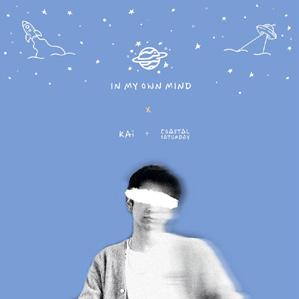

@coastalsaturday @joshphil.mp3 @kainoatay @ramirez_design

Georgie Jensen is an aspiring anthropology major at Linn-Benton Community College. She is also a multi-talented artist, focusing in textile work like knitting as well as photography and is dipping her paintbrush into watercolor painting.
Georgie began knitting while she was living in Mexico, specifically, in the back of a van with a woman she didn’t know and who only spoke Spanish. She now creates many wearable pieces for friends and family. Among these are many hats and shawls as well as blankets. Many of her pieces are big and intricate in pattern and colors. One of the main things she hopes people gain from her knits is that they are comfortable and cozy. Her current project is a hat for her son and her favorite piece is a big blanket she made for herself where every 10 layers is a new type of pattern and stitch. We discussed how for the majority of her projects, Georgie creates her own stitch patterns, which if you’ve tried to do this, you know it’s hard. It requires a lot of perfection and attention to detail, which seeing many of these pieces, is very well done.


While the main inspiration for creating comes from a need, whether that’s a need for a cozy addition to one’s closet or the need to create, Georgie is really interested in trying new ways to make art. She said that something she’s very interested in learning more about is weaving and spinning yarn.
Aside from making beautiful, intricate and indeed, cozy knits, Georgie also focuses her talents on the camera. She uses a Canon Rebel T5 and with it, captures images that fascinate her. The reason Georgie got into photography was because she wanted to capture her textile work in a way that was her own, and now just prefers to have images that are her own, that she was able to manipulate and create on her own. After taking a community ed class at the Chemeketa Community College, she was able to understand how to make her images look exactly how she’d wanted. Georgie said her favorite things to photograph are among nature, including incredible landscapes and patterns among the flora in the



Pacific Northwest. She takes photos of mushrooms and flowers and prefers to leave scenes she captures completely alone so it doesn’t look too staged. Her favorite landscapes include ones from the Riverfront park in Salem and the William R. Finley National Refuge natural area.
Along with using photography to create something of her own, we also discussed that she experiments with making fabric dyes using different plants like beets and butterfly pea flowers. Similar to using dye, Georgie also dabbles in painting, specifically with watercolor. She says she wanted to do something that would exercise a bit of the imperfection aspect of art: watercolor is something that’s decently uncontrolled, given its watery nature. On a postcard-size painting of a fish Georgie described that she was experimenting with color layering and said she really enjoyed just playing with ways of dropping color and letting it dry over the almost two weeks it took her to feel like the piece was complete.
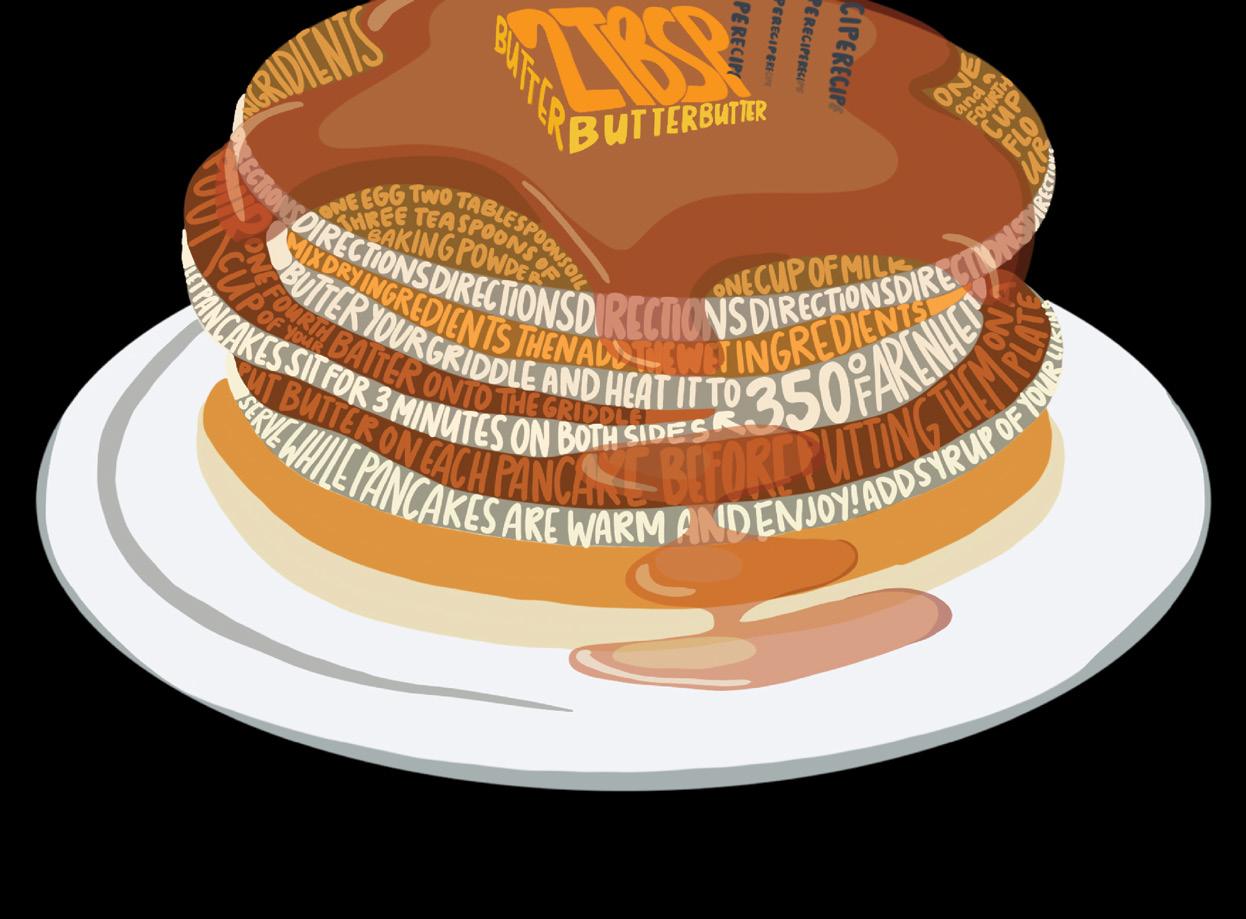

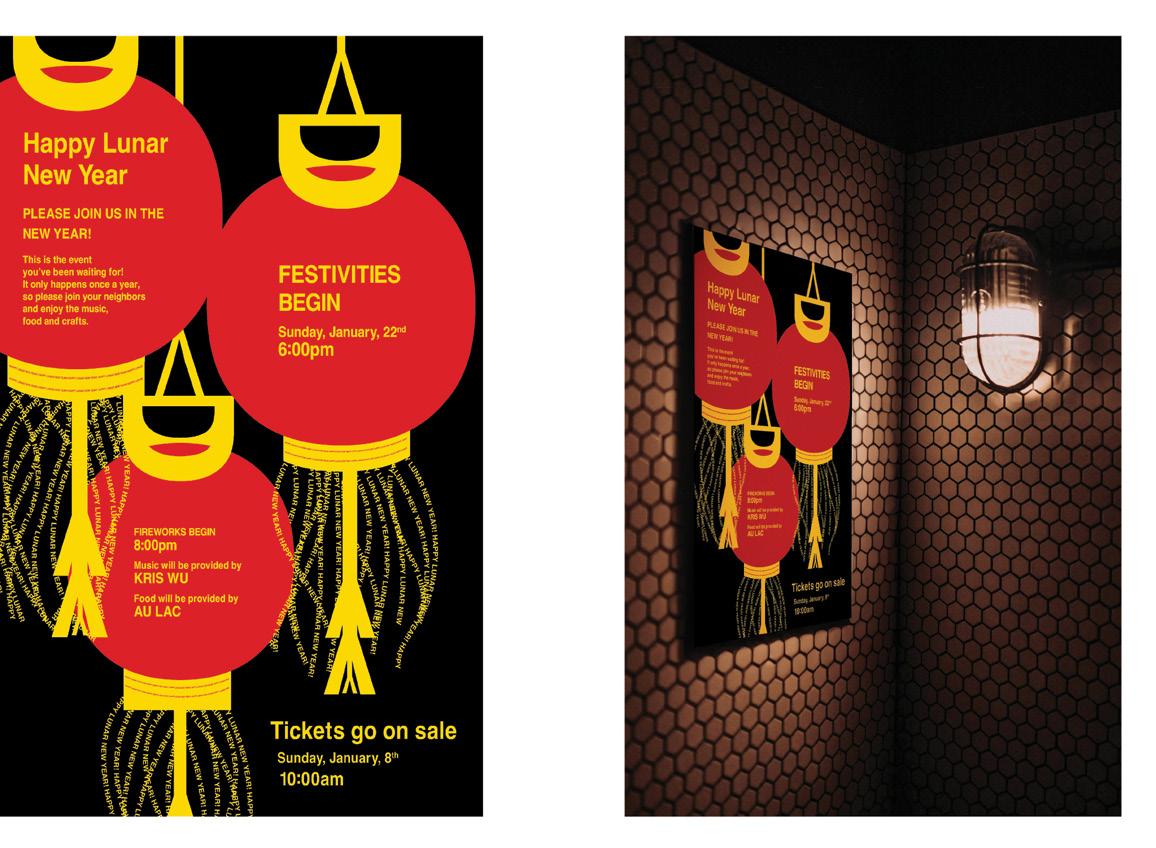





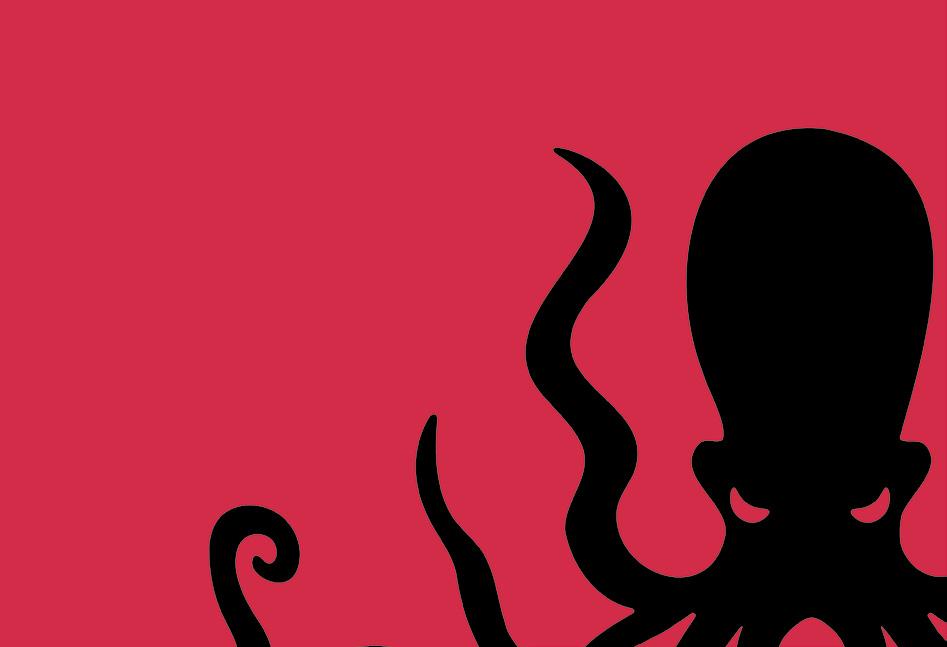

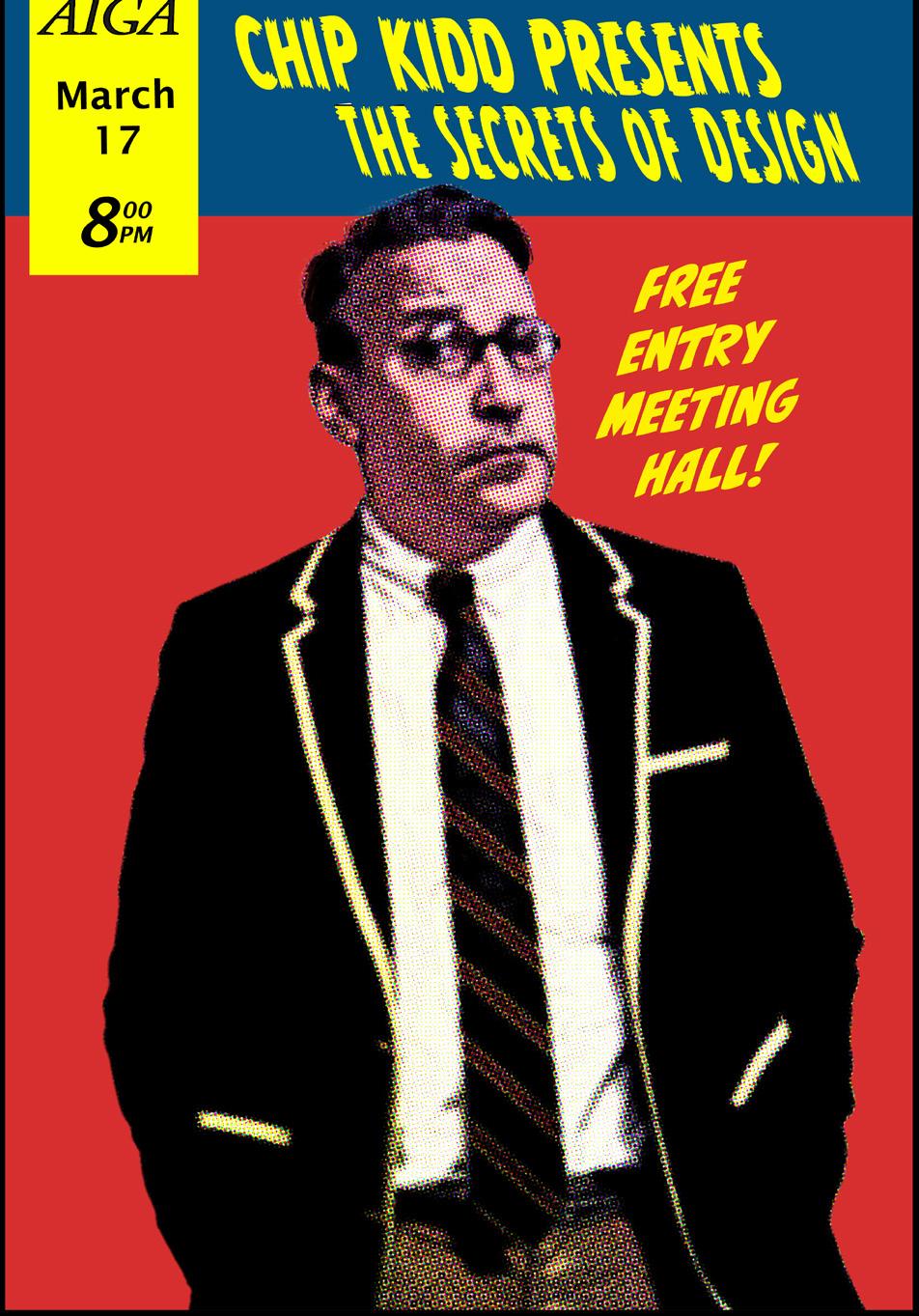




The end to another academic year is approaching as students of LBCC's Visual Communications prepare the culmination of their workfortheirannualPortfolioShow. Checkoutthesedesignsaswell astherestofthedesignworkofthis year's class in South Santiam Hall, andweencouragevisitorstoattend theirfinalportfoliopresentationsinIA 120onJune12startingat5pm.


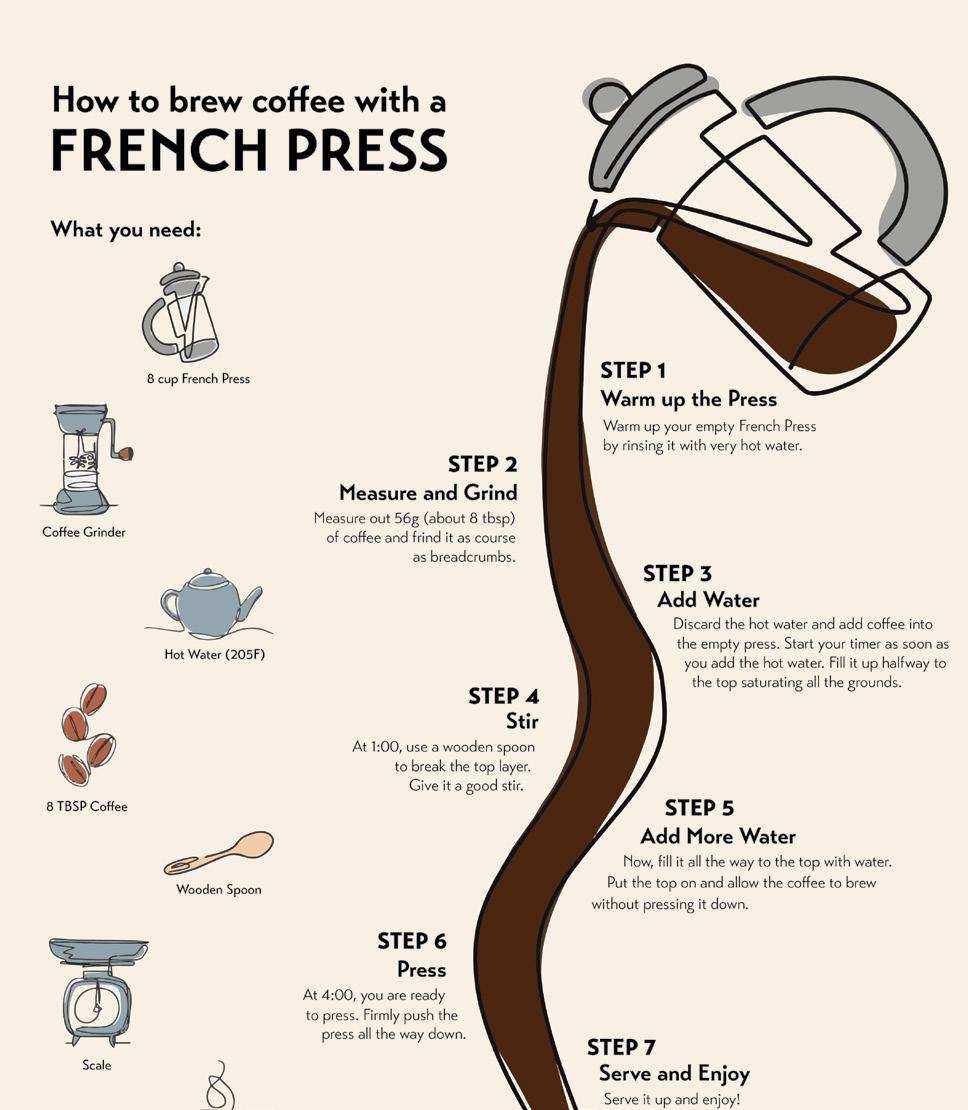

Kimetsu No Yaiba: The Movie — To the Hashira Training
MOVIE: Demon Slayer Kimetsu No Yaiba: The Movie To the Hashira Training
DIRECTOR: Sotozuki Haruo (Based on the graphic novel series by Gotoge Kyoharu)
STARRING: Hanae Netsuki, Kawanishi Kengo, Kito Akari, Shimono Hiro, and Matsuoka Yoshitsugu
RATED: R
OVERALL RATING: ★★★★
This past February, Demon Slayer Kimetsu No Yaiba: The Movie- To the Hashira Training saw release in theaters around the world. Following the smash success of 2021’s Demon Slayer Kimetsu no Yaiba: The Movie- Mugen Train (which surpassed Makoto Shinkai’s Your Name as the highest-grossing anime film ever worldwide), the movie sets the stage for the next chapter of the story.
The film is based on the best selling manga by Gotoge Kyoharu, and adapts material that has yet to be covered by the TV anime. After a highlight reel of the story so far, the main story acts as a prelude to the “Hashira Training arc” of the graphic novel series. As many members of the Demon Slayer Corps are dying or rendered unable to fight, a new generation must be trained to take up the fight against the army of demons led by Muzan Kibutsuji.
On a budget equivalent to $15 million USD, the film contains some of the best traditional animation seen in years. The story combines elements of action, horror and Taishoera Japanese period drama to great effect. It does
words by STEVEN PRYORrequire a working knowledge of the anime and manga up to the point the film adapts to follow, but the plot does flow reasonably well over 103 minutes.
Though the compilation film may be a subgenre that has largely faded from the public consciousness, this movie does make a reasonably effective use of the format. It will be interesting to see how the anime adapts the story for television (since the TV adaptations of the “Mugen Train” and “Swordsmith Village” arcs contained new material not shown in their respective movies).
While the film may not win over newcomers, it is an ideal way for fans to get ready for the television adaptation of the manga storyline this May. Overall, Demon Slayer Kimetsu no Yaiba: The Movie is definitely another enjoyable film outing for the franchise. With the TV anime set to resume this May, now is the ideal time to check this movie out.

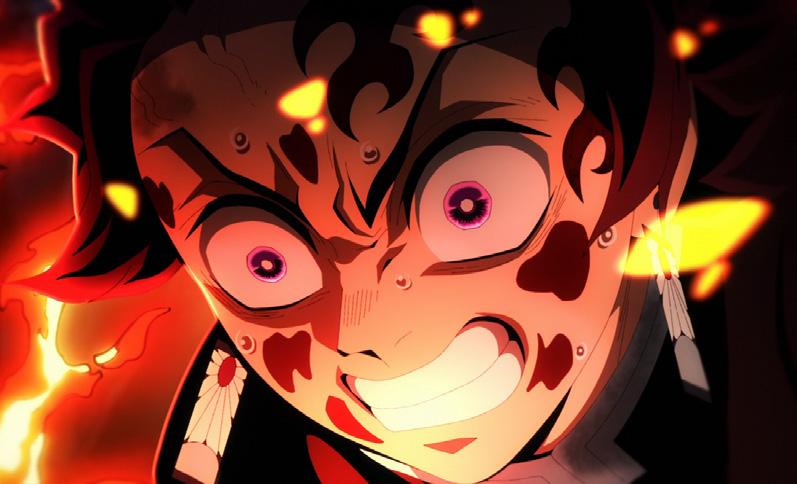

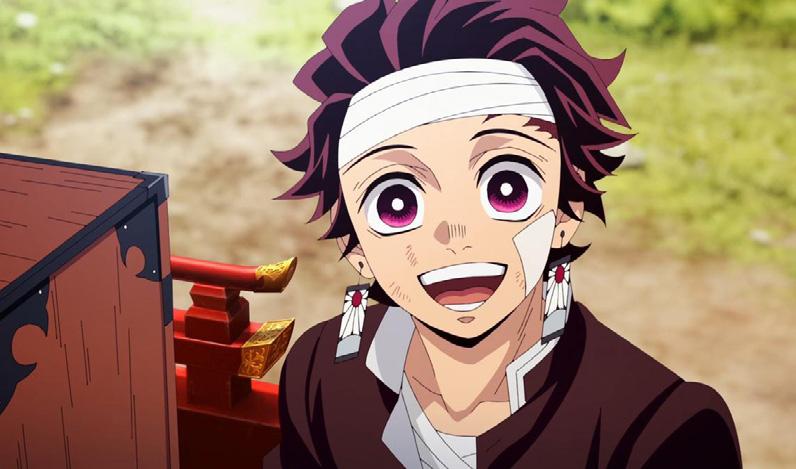


MOVIE: Monkey Man
DIRECTOR: Dev Patel
STARRING: Dev Patel, Pitobash Tripathy, Sharlto Copley
RATED: R
OVERALL RATING: ★★★★★
bloody finger presses the up arrow on the elevator, leaving behind a crimson blotch on the white button. The backdrop of red-paneled lights silhouettes our dark-suited protagonist. Finally, the doors open, revealing our mysterious figure: Monkey Man.Directed by and starring Dev Patel, "Monkey Man" tells the story of an underground fighter and his journey to enact revenge against the political forces that killed his mother. The film is an action-packed thriller that boasts several impressive fight scenes (albeit pretty gory), an engaging plot, and masterful cinematography. In the two weeks following the movie's release in the U.S., the film has received mostly positive reviews. On the film review aggregator site Rotten Tomatoes, the picture has gained a critic score of 88% and an audience score of 84%. Writer Shirley Li of The Atlantic lauds the film as "A stylish thriller that's also a cathartic unleashing of Patel as a performer and storyteller." In her review, Li praises Patel for his commitment and contribution to the project. Li also likens Patel's protagonist to a mixture of his past characters and reveres the project as a film only Patel could make.
Much of the film works around the legend of Hanuman, a Hindu deity whose complexion is half monkey and half man. The tale motivates our lead character, who wears a gorilla mask and adopts the name "Monkey Man" while fighting at the underground boxing facility. One of my favorite parts about the film was its combat and action sequences. A particular scene that stood out to me was a battle between our hero and Rana Singh, one of the movie's primary antagonists, in a lavish nightclub bathroom. The duel has many creative and zany moments between the two combatants, such as the destruction of a fish tank and the fight to retrieve a gun from a toilet bowl. Another entertaining sequence was a police chase through the streets where our lead evades authorities in a supercharged tuk-tuk. The scene features a perfect blend of
words by ETHAN BIRMINGHAMcomedy and suspense that ends surprisingly.
One thing that caught me off guard was the comedic moments throughout the film. Despite the rather solemn storyline, there are a few jokes that you can't help but cackle at. Most of these come from Alphonso, a loveable side character who aids our protagonist during his escapades.
However, the movie is far from a comedy, with certain scenes that are difficult to watch. As I had briefly mentioned earlier, there are some graphic depictions of violence and murder that some might consider upsetting. There are also brief moments that portray sexual assault, which is uncomfortable for the viewer. I would not recommend the movie to those who struggle with such sensitive subject matter.
My favorite aspect of the film would have to be its cinematography. Most scenes involve some element of clever camerawork and adequate tone-setting lighting. One of my favorite scenes from the movie was the depiction of a wallet passing from character to character through a changing scenery. As the wallet changes hands, the individual shots of the wallet alternate seamlessly, which is satisfying and fun for the audience to watch.
In an interview on The Kelly Clarkson Show, Patel shared his experiences on the creation of the film and its inspiration. "I just wanted to create the film that young Dev always wanted to see," said Patel. During the interview, Patel also described his love for action movies and the desire he had for his character's portrayal to be reminiscent of his hero, Bruce Lee. Overall, I would recommend "Monkey Man" to anyone wanting to watch a dazzling thriller that adds a few twists to the action genre. While I have admittedly not watched many action films in total, "Monkey Man" still ranks as one of my favorites. I will definitely be giving the movie a rewatch and would strongly advise others to do the same.
BUSINESS: Patty’s Thai Kitchen
ADDRESS: 6435 Old Salem Rd NE Suite 104, Albany, OR
OVERALL RATING: ★★★★★
words by MASON WILLS photos by RYAN JANOWITZPatty’s Thai Kitchen is a small food truck right off of I-5 and is a hidden gem in the Albany area. It’s located next to the Love’s Truck Stop in Millersburg so it is a little out of the way for anyone living in Albany, but it is very much worth the trip.
The truck itself is very nice. The menu is clear with pictures of every meal and prices displayed prominently. It has a very nice ambiance and the owners are really nice and open to questions.
The prices are pretty typical of food truck prices in the area. There are four choices of protein that are all reasonably priced. Chicken and Tofu is $13, Shrimp is $15, and Beef is $16. There is a great variety of meals as well with Pad Thai, Drunken Noodles, Orange Chicken, and many more meals. The side dishes are also very tasty with cream cheese wontons, potstickers, and spring rolls all being phenomenal. The Thai Tea is also highly recommended and they’ll give you a refill while you wait for your food.
The serving size per meal is massive so you are definitely getting your money's worth. Depending on how hungry you are you’ll probably have some leftovers after you finish eating.
All the food is made in house by one of the owners. This includes the teriyaki sauce, orange sauce, and breading for the chicken which are all made with the owner's own recipe. The meats are hand sliced and the breading on the chicken is never overpowering. This really makes the establishment have a homemade feel and elevates the already amazing food even more.
It’s in a food court set up with multiple other food trucks and with that there is plenty of seating that is great for late spring and summer trips to get food. There is also a sitting area inside a shipping container and another under a metal canopy that allows for seating during the rainy season as well.
With tasty food, nice owners, and great portions, this is a must eat at food truck that everyone should try.









“Houdini” by Foster the People is about the artist’s fear of rejection. The artist wants to pursue experimental ideas but feels pressured to make music that appeals to the masses. Finding the balance between making what you want and what is practical is an idea that applies to any creative career as well as journalism.













40. Touchscreen move
41. Put some life into
44. "___ Maria"
45. Short time period
46. Irritated
48. Highest mountain in North America
49. One who's out, in an old saying
50. Opinionated articles
53. Tried to hit the ball (in baseball or cricket)
55. Mysterious
57. Generous, perhaps
58. Break out of jail
59. "Doggone it!"
60. "Of the", in Spanish
40. Having almost no slack
42. Spacious
43. Landers of advice column fame
44. Sound booster
47. Morning cupful, perhaps
48. Fawn's mom
51. Greedy sort
52. Competes (for)
54. Has to have
56. Round that's popular at Girl
Scout gatherings
60. Salvador with an easel
61. Soft palate dangler
62. Hindu deity
63. English boarding school
64. Basic principle
65. "Now ___ me down to sleep ..."
66. Indecent
67. Outer parts
68. The number one, in German
Complete the grid so each row, column, and 3x3 box (in bold borders) contains every digit.



“Make sure to take a break from screens every day and do something that you find relaxing, whether it’s reading a book, going for a walk, or meditating. It’s a simple way to help lower your stress and feel better overall.”
-Travis, SLC President
“My mental health tip is to engage in meditation and/or mindfulness. Research shows that relaxation exercises, such as meditation, can improve your state of mind and outlook on life.”
-Tim, Student Engagement Leader
“One thing that helps with my mental health is to go for walks with my family and dog. Especially on days where I feel depressed, I force myself outside for a walk. It usually improves my mood a bit.”
-Ashley, Student Engagement Leader
“Exercising for even thirty minutes a day can help improve your mood with those natural endorphins!”
- Gracie, Campus Outreach Director
“My mental health tip is to be kind to yourself. It can be an easy thing to forget. Research shows it’s beneficial to our mental health and wellbeing.”
-Bri, Student Engagement Leader
Zeph’s Mental Health Tip
